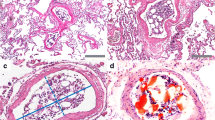Abstract
Objective
To verify whether the determination of the percentage of cells recovered by bronchoalveolar lavage and containing fat inclusions is a useful diagnostic tool of posttraumatic pulmonary fat embolism.
Design
Prospective study.
Setting
Surgical Intensive Care Units in two university hospitals.
Patients
56 successive trauma patients needing prolonged postinjury mechanical ventilation, including 4 with clinical definite fat embolism syndrome, 5 in whom the diagnosis had been clinically suspected but was impossible to confirm or exclude before bronchoscopy, and 47 with no clinical evidence of the syndrome. Control groups included 8 patients without previous trauma who developed ARDS and 6 healthy surgical patients.
Methods
Bronchoalveolar lavage was performed within the first posttraumatic 3 days in trauma patients, at the beguining of the pulmonary disease in non trauma ARDS patients and just after anesthesic induction in healthy ortopedic patients. The magnitude of lipid content in alveolar cells was compared with the clinical pattern of the pulmonary fat embolism syndrome retrospectively evaluated at the seventh day postinjury in trauma patients.
Results
All the patients with definite fat embolism syndrome had more than 70% of lavage cells containing fat droplets. The group of patients in whom the diagnosis of the fat embolism syndrome was suspected had percentages of fat cells above 30% in 4 out of 5 patients. A percentage of fat cells above 30% was only observed in 7 out of the 47 patients without clinical evidence of the syndrome. The percentage varied between 0% to 35% in the group of non trauma ARDS patients and between 0 to 5% in healthy surgical patients.
Conclusion
Lipid inclusions in alveolar cells are common during traumatic and non-traumatic respiratory failure. Determination of the percentage of cells recovered by bronchoalveolar lavage and containing fat droplets may contribute to the diagnosis of the fat embolism syndrome in mechanically-ventilated trauma patients with respiratory failure provided that the significant threshold would be 30%.
Similar content being viewed by others
References
Gosling HR, Pellegrini VD (1982) Fat embolism syndrome. Clin Orthop 165: 68–82
Peltier LF (1988) Fat embolism: a perspective. Clin Orthop 232: 263–270
Chastre J, Fagon JY, Soler P et al (1990) Bronchoalveolar lavage for rapid diagnosis of the fat embolism syndrome in trauma patients. Ann Intern Med 113:583–588
Gurd AR (1970) Fat embolism: an aid to diagnosis. J Bone Joint Surg [Br] 52: 732–737
Schonfeld SA, Ploysongsang Y, Dilisio R, Crissman JD, Miller E, Hammerschmidt DE, Jacob HS (1983) Fat embolism prophylaxis with corticosteroids. A prospective study in high-risk patients. Ann Intern Med 99: 438–443
Ognibene FP, Martin SE, Parker MM et al (1986) Adult respiratory distress syndrome in patients with severe neutropenia. N Engl J Med 315: 547–551
Shier MR, Wilson RF, James RE, Riddle J, Mammen EF, Pederson HE (1977) Fat embolism prophylaxis: a study of four treatment modalities. J Trauma 17: 621–629
Baker SP, O'Neill B, Haddon W, Long WB (1974) The injury severity score: a method for describing patients with multiple injuries and evaluating emergency care. J Trauma 14: 187–196
Le Gall JR, Loirat P, Alperovitch A et al (1984) A simplified acute physiology score for ICU patients. Crit Care Med 12: 975–981
Murray JF, Matthay MA, Luce JM, Flick MR (1988) An expanded definition of the adult respiratory distress syndrome. Am Rev Respir Dis 138: 720–723
Chastre J, Fagon JY, Soler P et al (1988) Diagnosis of nosocomial bacterial pneumonia in intubated patients undergoing ventilation: comparison of the usefulness of bronchoalveolar lavage and the protected specimen brush. Am J Med 85: 499–506
Corwin RW, Irwin RS (1985) The lipidladen alveolar macrophage as a marker of aspiration in parenchymal lung disease. Am Rev Respir Dis 132: 576–581
Reynolds HY (1987) Bronchoalveolar lavage: state of the art. Am Rev Respir Dis 135: 250–263
Lahiri B, Zu Wallack R (1971) The early diagnosis and treatment of fat embolism syndrome: a preliminary report. J Trauma 17: 956–960
Vedrinne JM, Guillaume C, Gagnieu MC et al (1992) Bronchoalveolar lavage in trauma patients for diagnosis of fat embolism syndrome. Chest 102: 1323–1327
Gitin TA, Seidel T, Cera PJ, Glidewell OJ, Smith JL (1993) Pulmonary microvascular fat: the significance? Crit Care Med 21: 673–677
Cotran RS, Kumar V, Robbins SL (1989) Lipid pneumonia. In: Pathologic basis of disease, 4th edn. Saunders, Phyladelphia, pp 796–797
Hulman G (1988) Pathogenesis of non-traumatic fat embolism. Lancet 18: 1366–1367
Szabo G, Serenyi P, Kocsar L (1963) Fat embolism: fat absorption from the site of injury. Surgery 54: 756–760
Author information
Authors and Affiliations
Rights and permissions
About this article
Cite this article
Mimoz, O., Edouard, A., Beydon, L. et al. Contribution of bronchoalveolar lavage to the diagnosis of posttraumatic pulmonary fat embolism. Intensive Care Med 21, 973–980 (1995). https://doi.org/10.1007/BF01700658
Received:
Accepted:
Issue Date:
DOI: https://doi.org/10.1007/BF01700658



